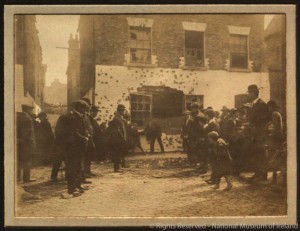Thomas Clarke’s signature, No. 16 Moore Street
Published in Artefacts, Issue 2 (March/April 2016), Volume 24By Lar Joye
![A piece of the wall taken from No. 16 Moore Street and inscribed ‘Thos. J. Clarke, 6th Day IR’ [Irish Republic]. (NMI)](https://www.historyireland.com/wp-content/uploads/2016/02/Clarke-signature-300x200.jpg)
A piece of the wall taken from No. 16 Moore Street and inscribed ‘Thos. J. Clarke, 6th Day IR’ [Irish Republic]. (NMI)

Moore Street after the Rising. (NMI)
The GPO was the headquarters of the Rising and from Wednesday 26 April was to become the main focus of attention for the British Army, as they realised its importance. The four artillery guns that the British Army had were focused first on bombarding Liberty Hall—which they mistakenly believed to be the rebel headquarters—and then on the GPO. Although the artillery was largely ineffective, fires quickly broke out in the surrounding area and it became impossible to defend the building. The rebels retreated to nearby Moore Street on Friday evening; their plan was to make their way to the Williams & Woods Sweet and Soap Factory on King’s Inns Street. Moving in three separate groups, over 200 rebels crossed Henry Street into Henry Place, heading towards the factory. By this stage, however, soldiers of the Royal Irish Regiment and the Sherwood Foresters had cordoned off the area with barricades.
When they saw the rebels at the bottom of Moore Lane they opened fire, killing a number of them at a building that has become known as the White House. Eventually the remaining rebels did get to No. 10 Moore Street and started to break down the walls between adjoining houses in an effort to escape the encircling British. At the same time, the O’Rahilly led a group of rebels across Henry Street to attack the Moore Street barricade, where he was wounded and later died. Of the 30 rebels who followed him, twenty were killed or wounded.
Despite the worsening situation, the rebels believed that they had begun a new era in Irish history, as this graffito written by Thomas Clarke reveals: ‘Thos. J. Clarke, 6th Day IR’ [Irish Republic]. After the Rising, Clarke’s widow, Kathleen, asked Batt O’Connor to return to No. 16 Moore Street to remove and preserve the writings that had been found on the walls and door jambs, as ‘they were her husband’s last message to his countrymen’. This he did for her, removing part of the wall, which is now on display in the National Museum of Ireland, Collins Barracks.
On Saturday 29 April, to avoid further loss of life, Patrick Pearse surrendered unconditionally to the British. Initial negotiations were conducted amidst the devastation on Moore Street under the protection of a white flag. By her bravery, Elizabeth O’Farrell saved many lives at the end of the Rising when she walked out into Moore Street to carry word to the British that the GPO garrison would lay down its arms.
Lar Joye is curator of military history at the National Museum of Ireland (Decorative Arts).
Further reading
F. Myles, ‘Beating the retreat: the final hours of the Easter Rising’, in L. Godson & J. Brück (eds), Making 1916: material and visual culture of the Easter Rising (Liverpool, 2015).
B. O’Connor, With Michael Collins in the fight for Irish independence (London, 1929).
















